Report: Developing a Feasible Android Business Idea for Vehicles
VerifiedAdded on 2021/06/18
|12
|2610
|46
Report
AI Summary
This report outlines a business idea for an Android-based vehicle troubleshooting system. The core concept involves developing software and a sensory device to be fitted in vehicles. This technology would allow drivers to scan their vehicles for potential flaws before driving, providing diagnostic information and suggesting solutions. The report analyzes the market gap, highlighting the need for such a product, and discusses the benefits, including enhanced safety, reduced vehicle theft concerns, and convenience. It evaluates the market and financial feasibility, proposing a business model that focuses on partnerships with vehicle manufacturers and government entities. The critical success factors are identified as patenting the idea, securing government support, and building strong customer relationships. The report concludes that the business idea has strong potential for success, given the identified market need and strategic considerations.
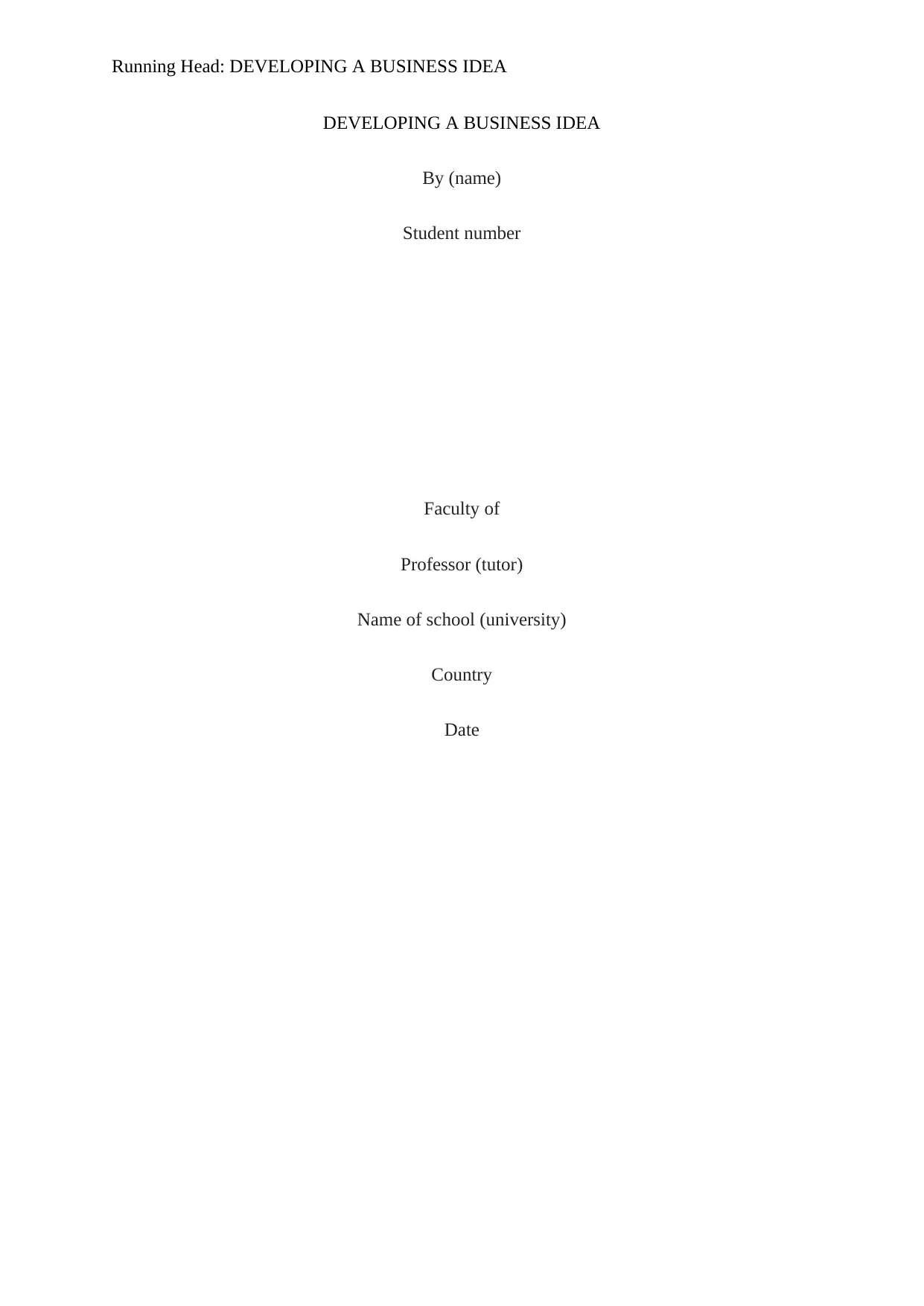
Running Head: DEVELOPING A BUSINESS IDEA
DEVELOPING A BUSINESS IDEA
By (name)
Student number
Faculty of
Professor (tutor)
Name of school (university)
Country
Date
DEVELOPING A BUSINESS IDEA
By (name)
Student number
Faculty of
Professor (tutor)
Name of school (university)
Country
Date
Paraphrase This Document
Need a fresh take? Get an instant paraphrase of this document with our AI Paraphraser
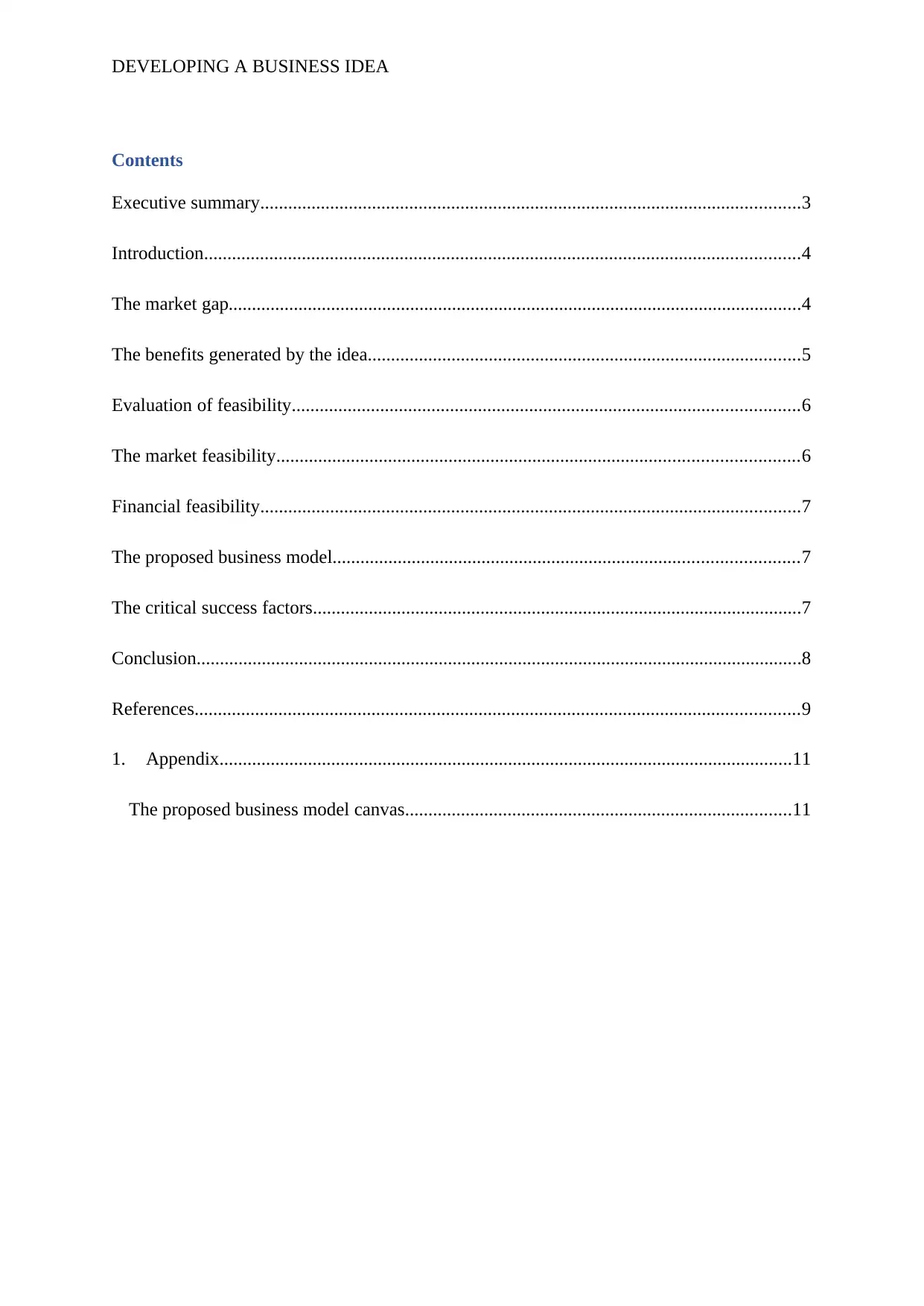
DEVELOPING A BUSINESS IDEA
Contents
Executive summary....................................................................................................................3
Introduction................................................................................................................................4
The market gap...........................................................................................................................4
The benefits generated by the idea.............................................................................................5
Evaluation of feasibility.............................................................................................................6
The market feasibility................................................................................................................6
Financial feasibility....................................................................................................................7
The proposed business model....................................................................................................7
The critical success factors.........................................................................................................7
Conclusion..................................................................................................................................8
References..................................................................................................................................9
1. Appendix...........................................................................................................................11
The proposed business model canvas...................................................................................11
Contents
Executive summary....................................................................................................................3
Introduction................................................................................................................................4
The market gap...........................................................................................................................4
The benefits generated by the idea.............................................................................................5
Evaluation of feasibility.............................................................................................................6
The market feasibility................................................................................................................6
Financial feasibility....................................................................................................................7
The proposed business model....................................................................................................7
The critical success factors.........................................................................................................7
Conclusion..................................................................................................................................8
References..................................................................................................................................9
1. Appendix...........................................................................................................................11
The proposed business model canvas...................................................................................11
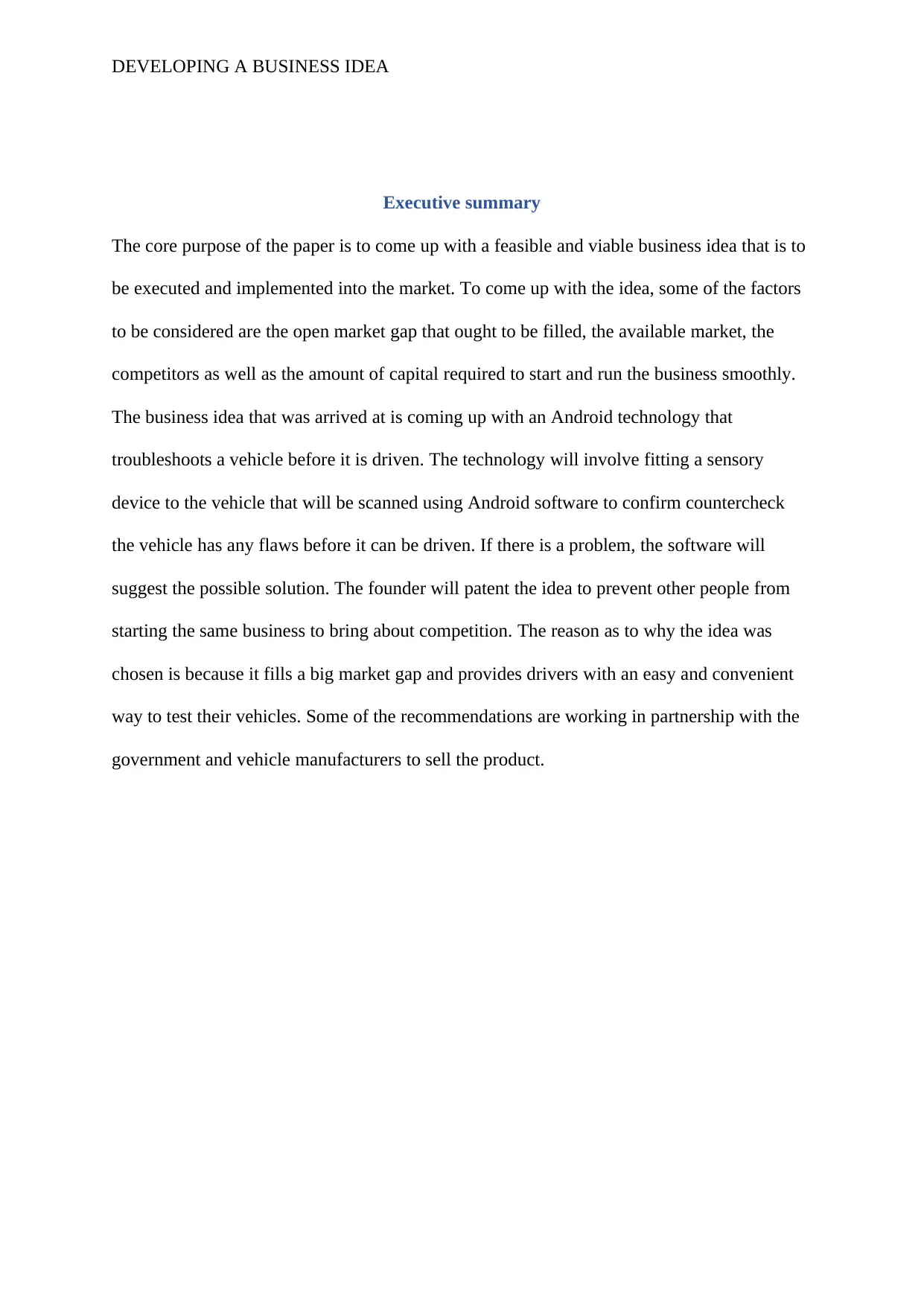
DEVELOPING A BUSINESS IDEA
Executive summary
The core purpose of the paper is to come up with a feasible and viable business idea that is to
be executed and implemented into the market. To come up with the idea, some of the factors
to be considered are the open market gap that ought to be filled, the available market, the
competitors as well as the amount of capital required to start and run the business smoothly.
The business idea that was arrived at is coming up with an Android technology that
troubleshoots a vehicle before it is driven. The technology will involve fitting a sensory
device to the vehicle that will be scanned using Android software to confirm countercheck
the vehicle has any flaws before it can be driven. If there is a problem, the software will
suggest the possible solution. The founder will patent the idea to prevent other people from
starting the same business to bring about competition. The reason as to why the idea was
chosen is because it fills a big market gap and provides drivers with an easy and convenient
way to test their vehicles. Some of the recommendations are working in partnership with the
government and vehicle manufacturers to sell the product.
Executive summary
The core purpose of the paper is to come up with a feasible and viable business idea that is to
be executed and implemented into the market. To come up with the idea, some of the factors
to be considered are the open market gap that ought to be filled, the available market, the
competitors as well as the amount of capital required to start and run the business smoothly.
The business idea that was arrived at is coming up with an Android technology that
troubleshoots a vehicle before it is driven. The technology will involve fitting a sensory
device to the vehicle that will be scanned using Android software to confirm countercheck
the vehicle has any flaws before it can be driven. If there is a problem, the software will
suggest the possible solution. The founder will patent the idea to prevent other people from
starting the same business to bring about competition. The reason as to why the idea was
chosen is because it fills a big market gap and provides drivers with an easy and convenient
way to test their vehicles. Some of the recommendations are working in partnership with the
government and vehicle manufacturers to sell the product.
⊘ This is a preview!⊘
Do you want full access?
Subscribe today to unlock all pages.

Trusted by 1+ million students worldwide
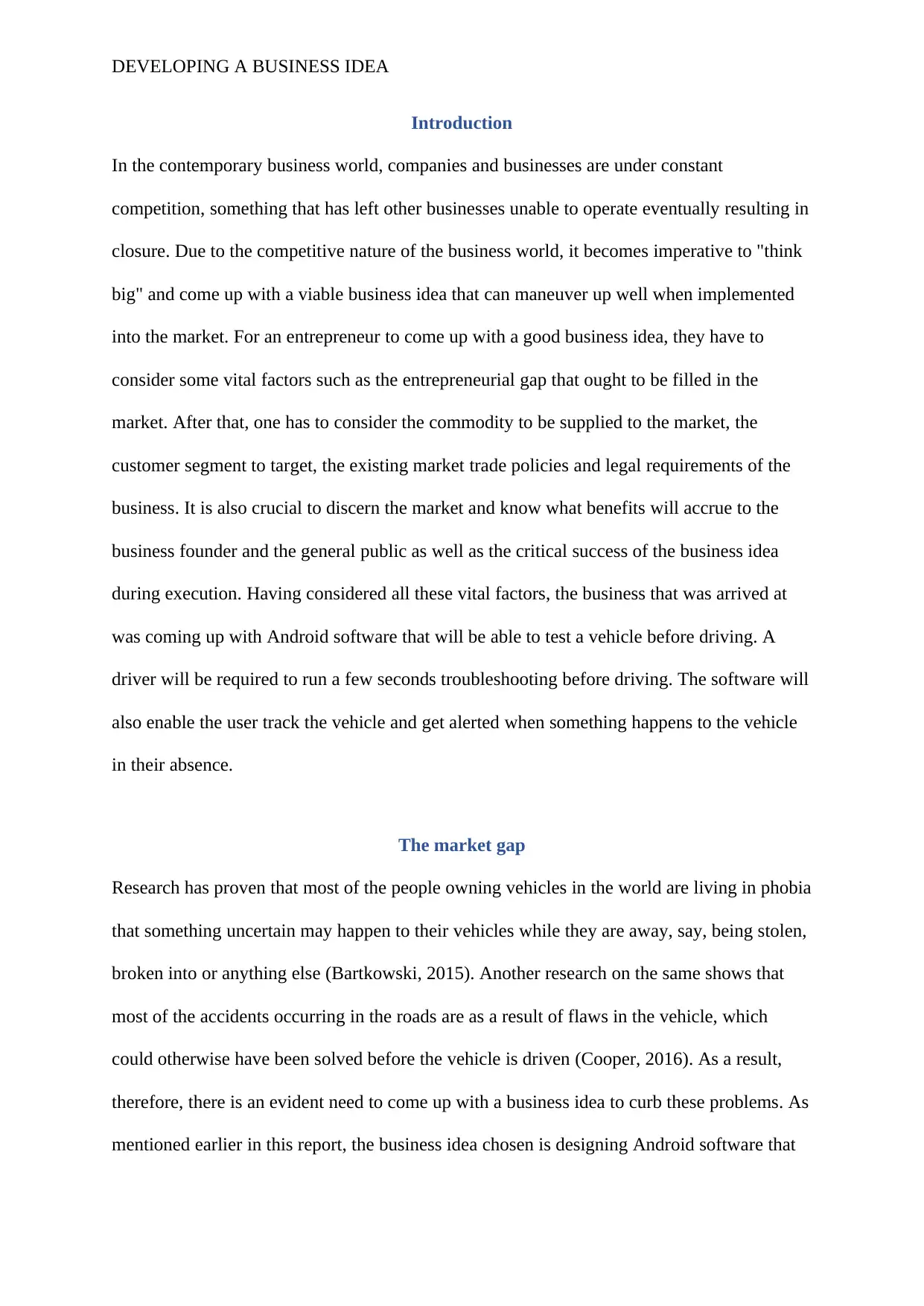
DEVELOPING A BUSINESS IDEA
Introduction
In the contemporary business world, companies and businesses are under constant
competition, something that has left other businesses unable to operate eventually resulting in
closure. Due to the competitive nature of the business world, it becomes imperative to "think
big" and come up with a viable business idea that can maneuver up well when implemented
into the market. For an entrepreneur to come up with a good business idea, they have to
consider some vital factors such as the entrepreneurial gap that ought to be filled in the
market. After that, one has to consider the commodity to be supplied to the market, the
customer segment to target, the existing market trade policies and legal requirements of the
business. It is also crucial to discern the market and know what benefits will accrue to the
business founder and the general public as well as the critical success of the business idea
during execution. Having considered all these vital factors, the business that was arrived at
was coming up with Android software that will be able to test a vehicle before driving. A
driver will be required to run a few seconds troubleshooting before driving. The software will
also enable the user track the vehicle and get alerted when something happens to the vehicle
in their absence.
The market gap
Research has proven that most of the people owning vehicles in the world are living in phobia
that something uncertain may happen to their vehicles while they are away, say, being stolen,
broken into or anything else (Bartkowski, 2015). Another research on the same shows that
most of the accidents occurring in the roads are as a result of flaws in the vehicle, which
could otherwise have been solved before the vehicle is driven (Cooper, 2016). As a result,
therefore, there is an evident need to come up with a business idea to curb these problems. As
mentioned earlier in this report, the business idea chosen is designing Android software that
Introduction
In the contemporary business world, companies and businesses are under constant
competition, something that has left other businesses unable to operate eventually resulting in
closure. Due to the competitive nature of the business world, it becomes imperative to "think
big" and come up with a viable business idea that can maneuver up well when implemented
into the market. For an entrepreneur to come up with a good business idea, they have to
consider some vital factors such as the entrepreneurial gap that ought to be filled in the
market. After that, one has to consider the commodity to be supplied to the market, the
customer segment to target, the existing market trade policies and legal requirements of the
business. It is also crucial to discern the market and know what benefits will accrue to the
business founder and the general public as well as the critical success of the business idea
during execution. Having considered all these vital factors, the business that was arrived at
was coming up with Android software that will be able to test a vehicle before driving. A
driver will be required to run a few seconds troubleshooting before driving. The software will
also enable the user track the vehicle and get alerted when something happens to the vehicle
in their absence.
The market gap
Research has proven that most of the people owning vehicles in the world are living in phobia
that something uncertain may happen to their vehicles while they are away, say, being stolen,
broken into or anything else (Bartkowski, 2015). Another research on the same shows that
most of the accidents occurring in the roads are as a result of flaws in the vehicle, which
could otherwise have been solved before the vehicle is driven (Cooper, 2016). As a result,
therefore, there is an evident need to come up with a business idea to curb these problems. As
mentioned earlier in this report, the business idea chosen is designing Android software that
Paraphrase This Document
Need a fresh take? Get an instant paraphrase of this document with our AI Paraphraser
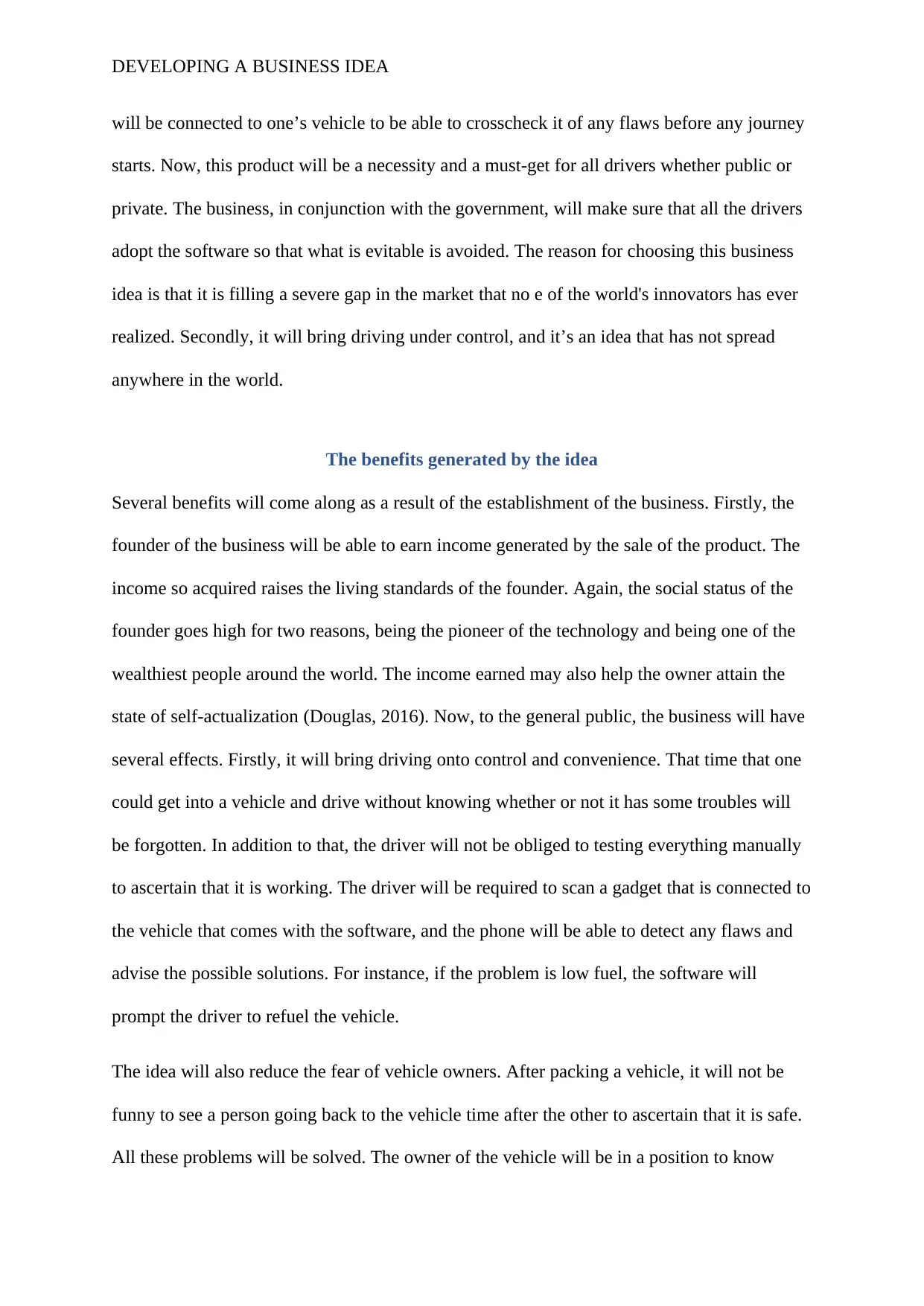
DEVELOPING A BUSINESS IDEA
will be connected to one’s vehicle to be able to crosscheck it of any flaws before any journey
starts. Now, this product will be a necessity and a must-get for all drivers whether public or
private. The business, in conjunction with the government, will make sure that all the drivers
adopt the software so that what is evitable is avoided. The reason for choosing this business
idea is that it is filling a severe gap in the market that no e of the world's innovators has ever
realized. Secondly, it will bring driving under control, and it’s an idea that has not spread
anywhere in the world.
The benefits generated by the idea
Several benefits will come along as a result of the establishment of the business. Firstly, the
founder of the business will be able to earn income generated by the sale of the product. The
income so acquired raises the living standards of the founder. Again, the social status of the
founder goes high for two reasons, being the pioneer of the technology and being one of the
wealthiest people around the world. The income earned may also help the owner attain the
state of self-actualization (Douglas, 2016). Now, to the general public, the business will have
several effects. Firstly, it will bring driving onto control and convenience. That time that one
could get into a vehicle and drive without knowing whether or not it has some troubles will
be forgotten. In addition to that, the driver will not be obliged to testing everything manually
to ascertain that it is working. The driver will be required to scan a gadget that is connected to
the vehicle that comes with the software, and the phone will be able to detect any flaws and
advise the possible solutions. For instance, if the problem is low fuel, the software will
prompt the driver to refuel the vehicle.
The idea will also reduce the fear of vehicle owners. After packing a vehicle, it will not be
funny to see a person going back to the vehicle time after the other to ascertain that it is safe.
All these problems will be solved. The owner of the vehicle will be in a position to know
will be connected to one’s vehicle to be able to crosscheck it of any flaws before any journey
starts. Now, this product will be a necessity and a must-get for all drivers whether public or
private. The business, in conjunction with the government, will make sure that all the drivers
adopt the software so that what is evitable is avoided. The reason for choosing this business
idea is that it is filling a severe gap in the market that no e of the world's innovators has ever
realized. Secondly, it will bring driving under control, and it’s an idea that has not spread
anywhere in the world.
The benefits generated by the idea
Several benefits will come along as a result of the establishment of the business. Firstly, the
founder of the business will be able to earn income generated by the sale of the product. The
income so acquired raises the living standards of the founder. Again, the social status of the
founder goes high for two reasons, being the pioneer of the technology and being one of the
wealthiest people around the world. The income earned may also help the owner attain the
state of self-actualization (Douglas, 2016). Now, to the general public, the business will have
several effects. Firstly, it will bring driving onto control and convenience. That time that one
could get into a vehicle and drive without knowing whether or not it has some troubles will
be forgotten. In addition to that, the driver will not be obliged to testing everything manually
to ascertain that it is working. The driver will be required to scan a gadget that is connected to
the vehicle that comes with the software, and the phone will be able to detect any flaws and
advise the possible solutions. For instance, if the problem is low fuel, the software will
prompt the driver to refuel the vehicle.
The idea will also reduce the fear of vehicle owners. After packing a vehicle, it will not be
funny to see a person going back to the vehicle time after the other to ascertain that it is safe.
All these problems will be solved. The owner of the vehicle will be in a position to know
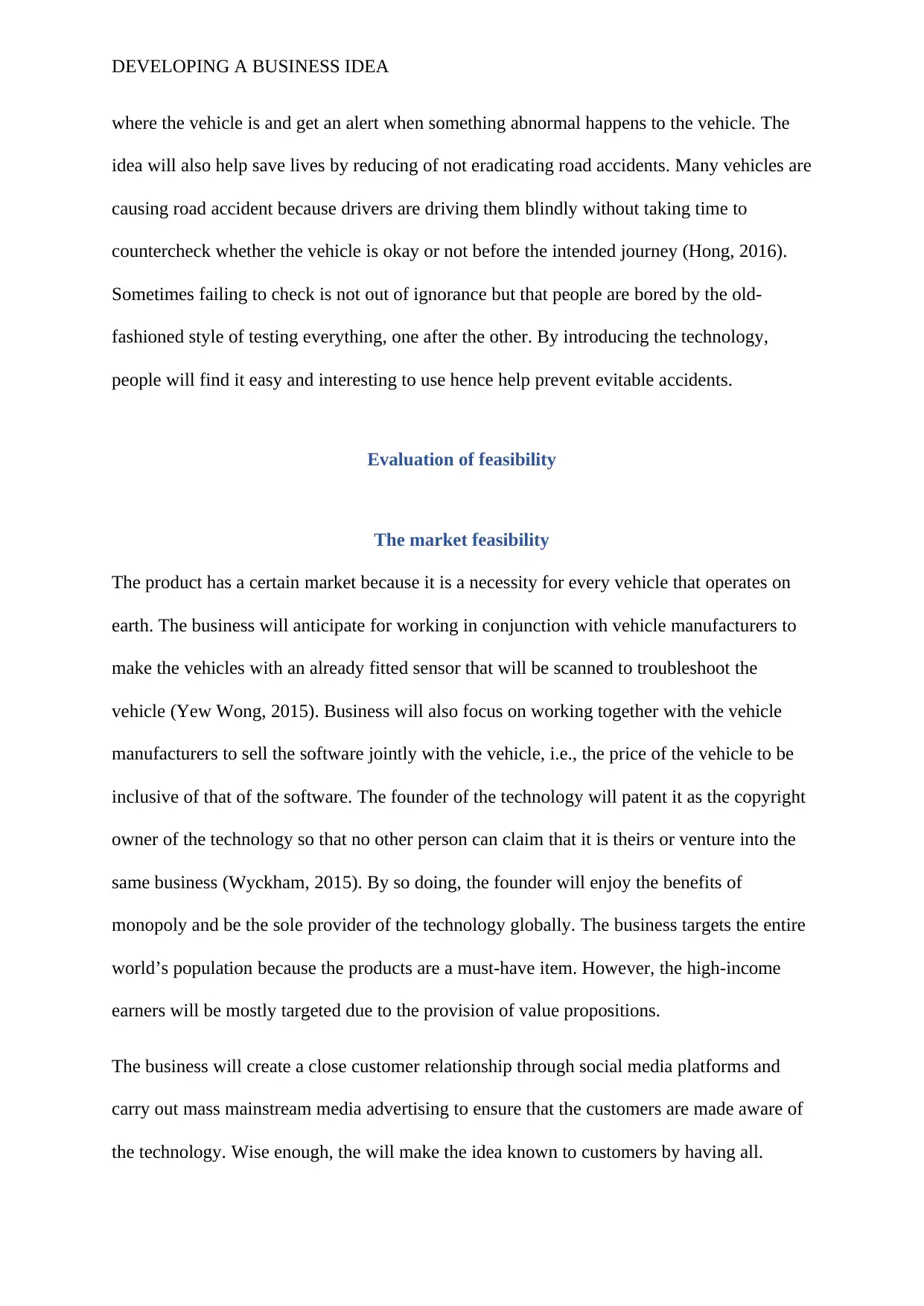
DEVELOPING A BUSINESS IDEA
where the vehicle is and get an alert when something abnormal happens to the vehicle. The
idea will also help save lives by reducing of not eradicating road accidents. Many vehicles are
causing road accident because drivers are driving them blindly without taking time to
countercheck whether the vehicle is okay or not before the intended journey (Hong, 2016).
Sometimes failing to check is not out of ignorance but that people are bored by the old-
fashioned style of testing everything, one after the other. By introducing the technology,
people will find it easy and interesting to use hence help prevent evitable accidents.
Evaluation of feasibility
The market feasibility
The product has a certain market because it is a necessity for every vehicle that operates on
earth. The business will anticipate for working in conjunction with vehicle manufacturers to
make the vehicles with an already fitted sensor that will be scanned to troubleshoot the
vehicle (Yew Wong, 2015). Business will also focus on working together with the vehicle
manufacturers to sell the software jointly with the vehicle, i.e., the price of the vehicle to be
inclusive of that of the software. The founder of the technology will patent it as the copyright
owner of the technology so that no other person can claim that it is theirs or venture into the
same business (Wyckham, 2015). By so doing, the founder will enjoy the benefits of
monopoly and be the sole provider of the technology globally. The business targets the entire
world’s population because the products are a must-have item. However, the high-income
earners will be mostly targeted due to the provision of value propositions.
The business will create a close customer relationship through social media platforms and
carry out mass mainstream media advertising to ensure that the customers are made aware of
the technology. Wise enough, the will make the idea known to customers by having all.
where the vehicle is and get an alert when something abnormal happens to the vehicle. The
idea will also help save lives by reducing of not eradicating road accidents. Many vehicles are
causing road accident because drivers are driving them blindly without taking time to
countercheck whether the vehicle is okay or not before the intended journey (Hong, 2016).
Sometimes failing to check is not out of ignorance but that people are bored by the old-
fashioned style of testing everything, one after the other. By introducing the technology,
people will find it easy and interesting to use hence help prevent evitable accidents.
Evaluation of feasibility
The market feasibility
The product has a certain market because it is a necessity for every vehicle that operates on
earth. The business will anticipate for working in conjunction with vehicle manufacturers to
make the vehicles with an already fitted sensor that will be scanned to troubleshoot the
vehicle (Yew Wong, 2015). Business will also focus on working together with the vehicle
manufacturers to sell the software jointly with the vehicle, i.e., the price of the vehicle to be
inclusive of that of the software. The founder of the technology will patent it as the copyright
owner of the technology so that no other person can claim that it is theirs or venture into the
same business (Wyckham, 2015). By so doing, the founder will enjoy the benefits of
monopoly and be the sole provider of the technology globally. The business targets the entire
world’s population because the products are a must-have item. However, the high-income
earners will be mostly targeted due to the provision of value propositions.
The business will create a close customer relationship through social media platforms and
carry out mass mainstream media advertising to ensure that the customers are made aware of
the technology. Wise enough, the will make the idea known to customers by having all.
⊘ This is a preview!⊘
Do you want full access?
Subscribe today to unlock all pages.

Trusted by 1+ million students worldwide
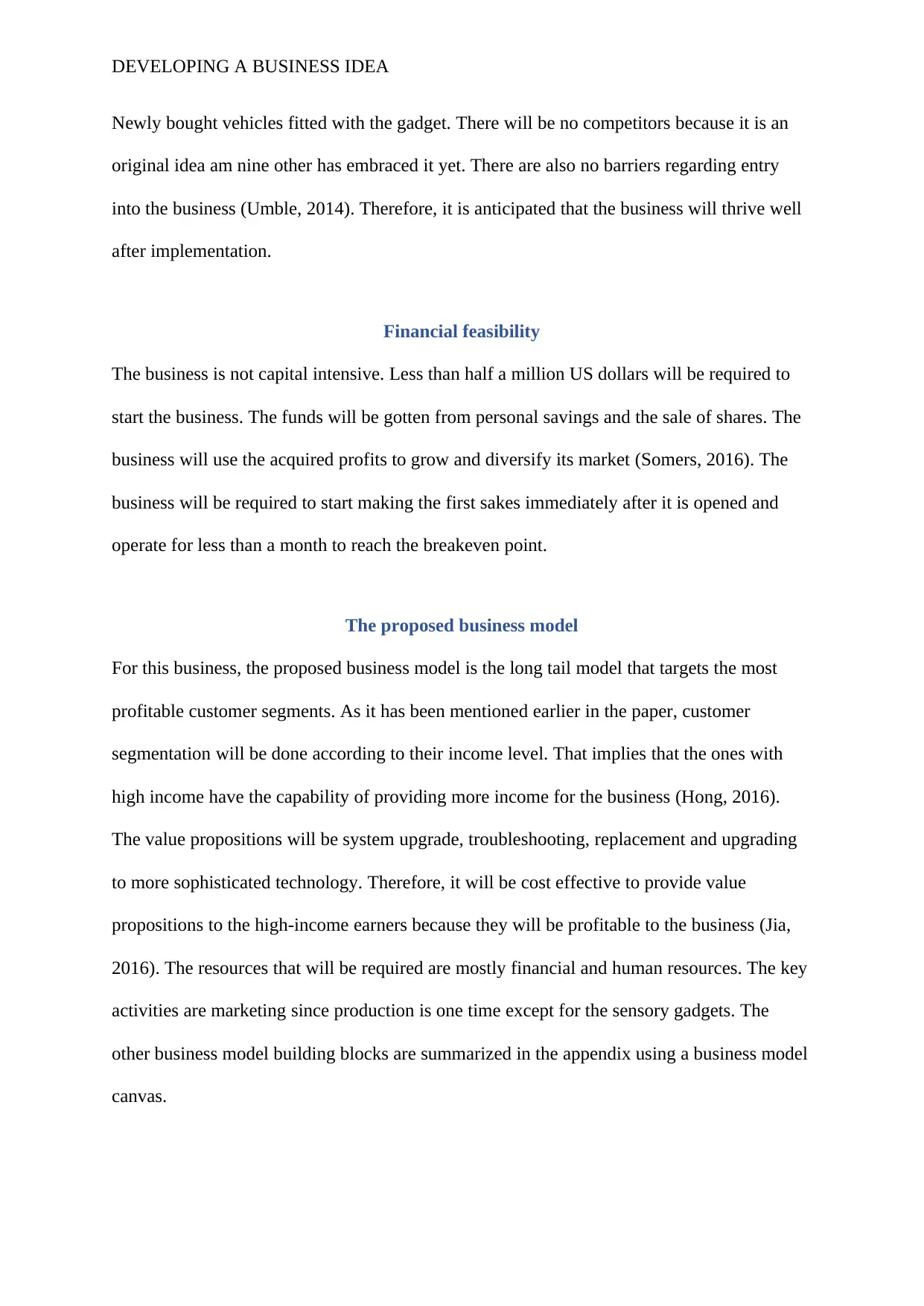
DEVELOPING A BUSINESS IDEA
Newly bought vehicles fitted with the gadget. There will be no competitors because it is an
original idea am nine other has embraced it yet. There are also no barriers regarding entry
into the business (Umble, 2014). Therefore, it is anticipated that the business will thrive well
after implementation.
Financial feasibility
The business is not capital intensive. Less than half a million US dollars will be required to
start the business. The funds will be gotten from personal savings and the sale of shares. The
business will use the acquired profits to grow and diversify its market (Somers, 2016). The
business will be required to start making the first sakes immediately after it is opened and
operate for less than a month to reach the breakeven point.
The proposed business model
For this business, the proposed business model is the long tail model that targets the most
profitable customer segments. As it has been mentioned earlier in the paper, customer
segmentation will be done according to their income level. That implies that the ones with
high income have the capability of providing more income for the business (Hong, 2016).
The value propositions will be system upgrade, troubleshooting, replacement and upgrading
to more sophisticated technology. Therefore, it will be cost effective to provide value
propositions to the high-income earners because they will be profitable to the business (Jia,
2016). The resources that will be required are mostly financial and human resources. The key
activities are marketing since production is one time except for the sensory gadgets. The
other business model building blocks are summarized in the appendix using a business model
canvas.
Newly bought vehicles fitted with the gadget. There will be no competitors because it is an
original idea am nine other has embraced it yet. There are also no barriers regarding entry
into the business (Umble, 2014). Therefore, it is anticipated that the business will thrive well
after implementation.
Financial feasibility
The business is not capital intensive. Less than half a million US dollars will be required to
start the business. The funds will be gotten from personal savings and the sale of shares. The
business will use the acquired profits to grow and diversify its market (Somers, 2016). The
business will be required to start making the first sakes immediately after it is opened and
operate for less than a month to reach the breakeven point.
The proposed business model
For this business, the proposed business model is the long tail model that targets the most
profitable customer segments. As it has been mentioned earlier in the paper, customer
segmentation will be done according to their income level. That implies that the ones with
high income have the capability of providing more income for the business (Hong, 2016).
The value propositions will be system upgrade, troubleshooting, replacement and upgrading
to more sophisticated technology. Therefore, it will be cost effective to provide value
propositions to the high-income earners because they will be profitable to the business (Jia,
2016). The resources that will be required are mostly financial and human resources. The key
activities are marketing since production is one time except for the sensory gadgets. The
other business model building blocks are summarized in the appendix using a business model
canvas.
Paraphrase This Document
Need a fresh take? Get an instant paraphrase of this document with our AI Paraphraser
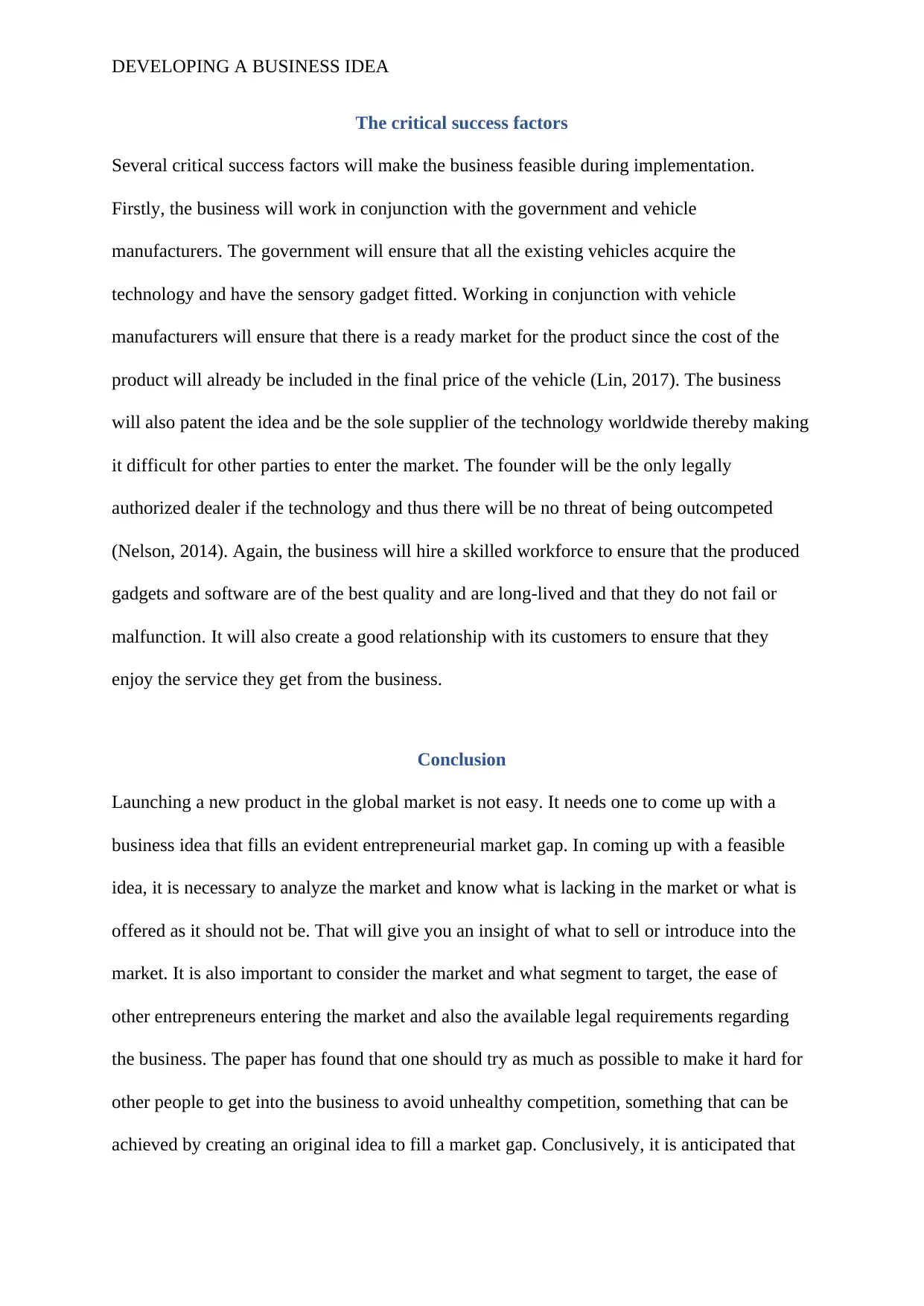
DEVELOPING A BUSINESS IDEA
The critical success factors
Several critical success factors will make the business feasible during implementation.
Firstly, the business will work in conjunction with the government and vehicle
manufacturers. The government will ensure that all the existing vehicles acquire the
technology and have the sensory gadget fitted. Working in conjunction with vehicle
manufacturers will ensure that there is a ready market for the product since the cost of the
product will already be included in the final price of the vehicle (Lin, 2017). The business
will also patent the idea and be the sole supplier of the technology worldwide thereby making
it difficult for other parties to enter the market. The founder will be the only legally
authorized dealer if the technology and thus there will be no threat of being outcompeted
(Nelson, 2014). Again, the business will hire a skilled workforce to ensure that the produced
gadgets and software are of the best quality and are long-lived and that they do not fail or
malfunction. It will also create a good relationship with its customers to ensure that they
enjoy the service they get from the business.
Conclusion
Launching a new product in the global market is not easy. It needs one to come up with a
business idea that fills an evident entrepreneurial market gap. In coming up with a feasible
idea, it is necessary to analyze the market and know what is lacking in the market or what is
offered as it should not be. That will give you an insight of what to sell or introduce into the
market. It is also important to consider the market and what segment to target, the ease of
other entrepreneurs entering the market and also the available legal requirements regarding
the business. The paper has found that one should try as much as possible to make it hard for
other people to get into the business to avoid unhealthy competition, something that can be
achieved by creating an original idea to fill a market gap. Conclusively, it is anticipated that
The critical success factors
Several critical success factors will make the business feasible during implementation.
Firstly, the business will work in conjunction with the government and vehicle
manufacturers. The government will ensure that all the existing vehicles acquire the
technology and have the sensory gadget fitted. Working in conjunction with vehicle
manufacturers will ensure that there is a ready market for the product since the cost of the
product will already be included in the final price of the vehicle (Lin, 2017). The business
will also patent the idea and be the sole supplier of the technology worldwide thereby making
it difficult for other parties to enter the market. The founder will be the only legally
authorized dealer if the technology and thus there will be no threat of being outcompeted
(Nelson, 2014). Again, the business will hire a skilled workforce to ensure that the produced
gadgets and software are of the best quality and are long-lived and that they do not fail or
malfunction. It will also create a good relationship with its customers to ensure that they
enjoy the service they get from the business.
Conclusion
Launching a new product in the global market is not easy. It needs one to come up with a
business idea that fills an evident entrepreneurial market gap. In coming up with a feasible
idea, it is necessary to analyze the market and know what is lacking in the market or what is
offered as it should not be. That will give you an insight of what to sell or introduce into the
market. It is also important to consider the market and what segment to target, the ease of
other entrepreneurs entering the market and also the available legal requirements regarding
the business. The paper has found that one should try as much as possible to make it hard for
other people to get into the business to avoid unhealthy competition, something that can be
achieved by creating an original idea to fill a market gap. Conclusively, it is anticipated that

DEVELOPING A BUSINESS IDEA
the business idea for coming up with a technology for troubleshooting, tracking and
maintaining control of vehicles will do well because all the necessary considerations have
been made.
the business idea for coming up with a technology for troubleshooting, tracking and
maintaining control of vehicles will do well because all the necessary considerations have
been made.
⊘ This is a preview!⊘
Do you want full access?
Subscribe today to unlock all pages.

Trusted by 1+ million students worldwide
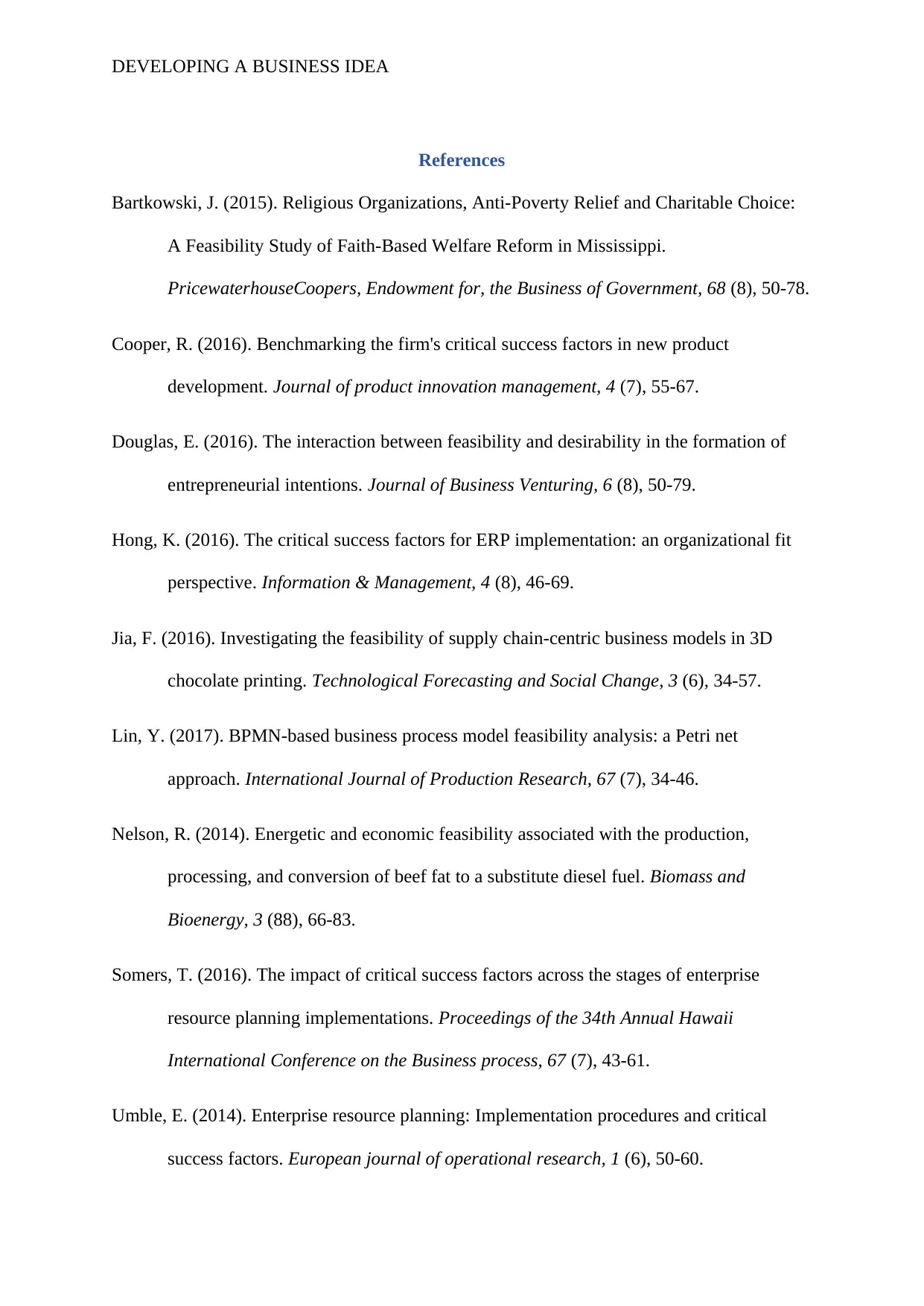
DEVELOPING A BUSINESS IDEA
References
Bartkowski, J. (2015). Religious Organizations, Anti-Poverty Relief and Charitable Choice:
A Feasibility Study of Faith-Based Welfare Reform in Mississippi.
PricewaterhouseCoopers, Endowment for, the Business of Government, 68 (8), 50-78.
Cooper, R. (2016). Benchmarking the firm's critical success factors in new product
development. Journal of product innovation management, 4 (7), 55-67.
Douglas, E. (2016). The interaction between feasibility and desirability in the formation of
entrepreneurial intentions. Journal of Business Venturing, 6 (8), 50-79.
Hong, K. (2016). The critical success factors for ERP implementation: an organizational fit
perspective. Information & Management, 4 (8), 46-69.
Jia, F. (2016). Investigating the feasibility of supply chain-centric business models in 3D
chocolate printing. Technological Forecasting and Social Change, 3 (6), 34-57.
Lin, Y. (2017). BPMN-based business process model feasibility analysis: a Petri net
approach. International Journal of Production Research, 67 (7), 34-46.
Nelson, R. (2014). Energetic and economic feasibility associated with the production,
processing, and conversion of beef fat to a substitute diesel fuel. Biomass and
Bioenergy, 3 (88), 66-83.
Somers, T. (2016). The impact of critical success factors across the stages of enterprise
resource planning implementations. Proceedings of the 34th Annual Hawaii
International Conference on the Business process, 67 (7), 43-61.
Umble, E. (2014). Enterprise resource planning: Implementation procedures and critical
success factors. European journal of operational research, 1 (6), 50-60.
References
Bartkowski, J. (2015). Religious Organizations, Anti-Poverty Relief and Charitable Choice:
A Feasibility Study of Faith-Based Welfare Reform in Mississippi.
PricewaterhouseCoopers, Endowment for, the Business of Government, 68 (8), 50-78.
Cooper, R. (2016). Benchmarking the firm's critical success factors in new product
development. Journal of product innovation management, 4 (7), 55-67.
Douglas, E. (2016). The interaction between feasibility and desirability in the formation of
entrepreneurial intentions. Journal of Business Venturing, 6 (8), 50-79.
Hong, K. (2016). The critical success factors for ERP implementation: an organizational fit
perspective. Information & Management, 4 (8), 46-69.
Jia, F. (2016). Investigating the feasibility of supply chain-centric business models in 3D
chocolate printing. Technological Forecasting and Social Change, 3 (6), 34-57.
Lin, Y. (2017). BPMN-based business process model feasibility analysis: a Petri net
approach. International Journal of Production Research, 67 (7), 34-46.
Nelson, R. (2014). Energetic and economic feasibility associated with the production,
processing, and conversion of beef fat to a substitute diesel fuel. Biomass and
Bioenergy, 3 (88), 66-83.
Somers, T. (2016). The impact of critical success factors across the stages of enterprise
resource planning implementations. Proceedings of the 34th Annual Hawaii
International Conference on the Business process, 67 (7), 43-61.
Umble, E. (2014). Enterprise resource planning: Implementation procedures and critical
success factors. European journal of operational research, 1 (6), 50-60.
Paraphrase This Document
Need a fresh take? Get an instant paraphrase of this document with our AI Paraphraser
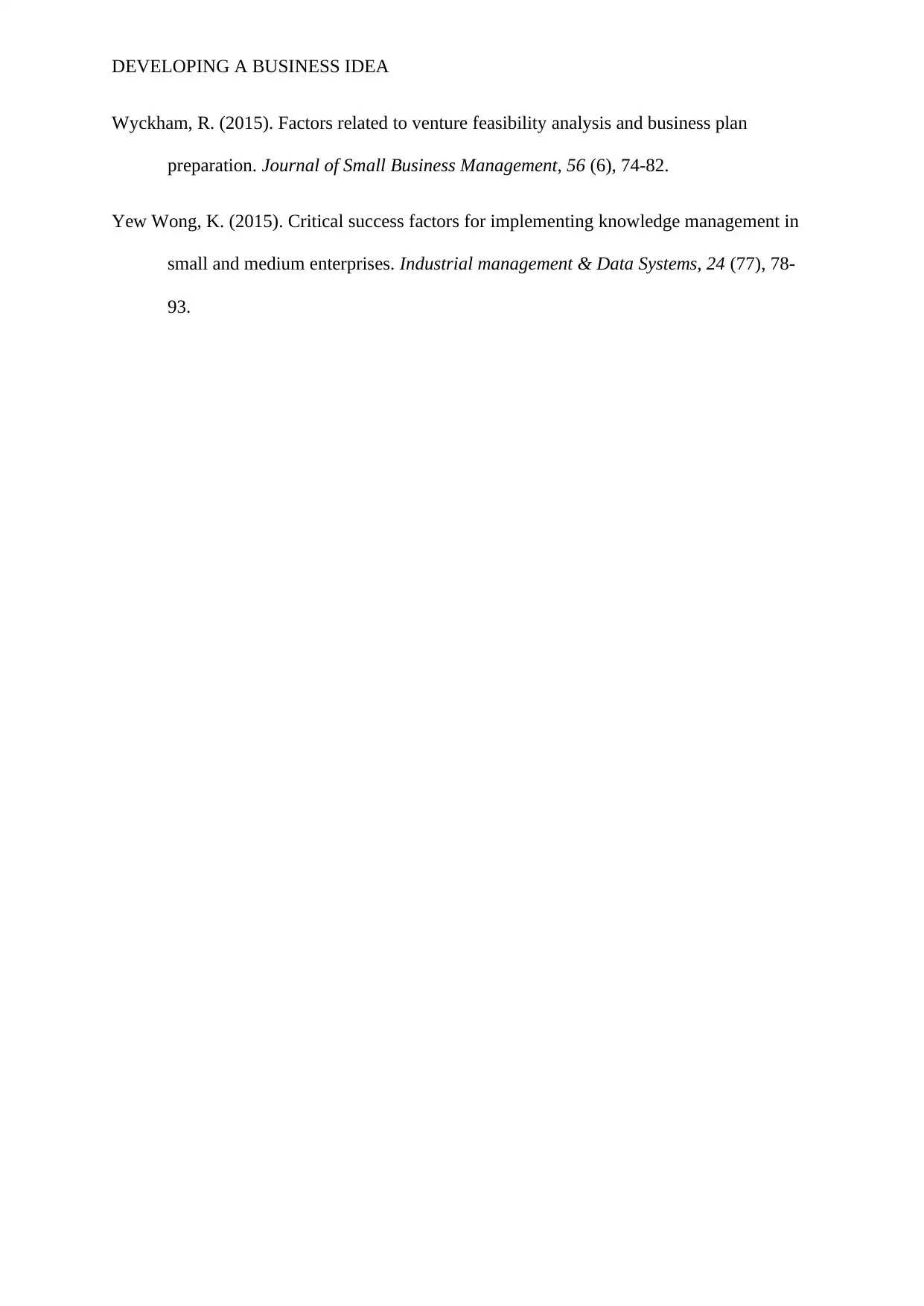
DEVELOPING A BUSINESS IDEA
Wyckham, R. (2015). Factors related to venture feasibility analysis and business plan
preparation. Journal of Small Business Management, 56 (6), 74-82.
Yew Wong, K. (2015). Critical success factors for implementing knowledge management in
small and medium enterprises. Industrial management & Data Systems, 24 (77), 78-
93.
Wyckham, R. (2015). Factors related to venture feasibility analysis and business plan
preparation. Journal of Small Business Management, 56 (6), 74-82.
Yew Wong, K. (2015). Critical success factors for implementing knowledge management in
small and medium enterprises. Industrial management & Data Systems, 24 (77), 78-
93.
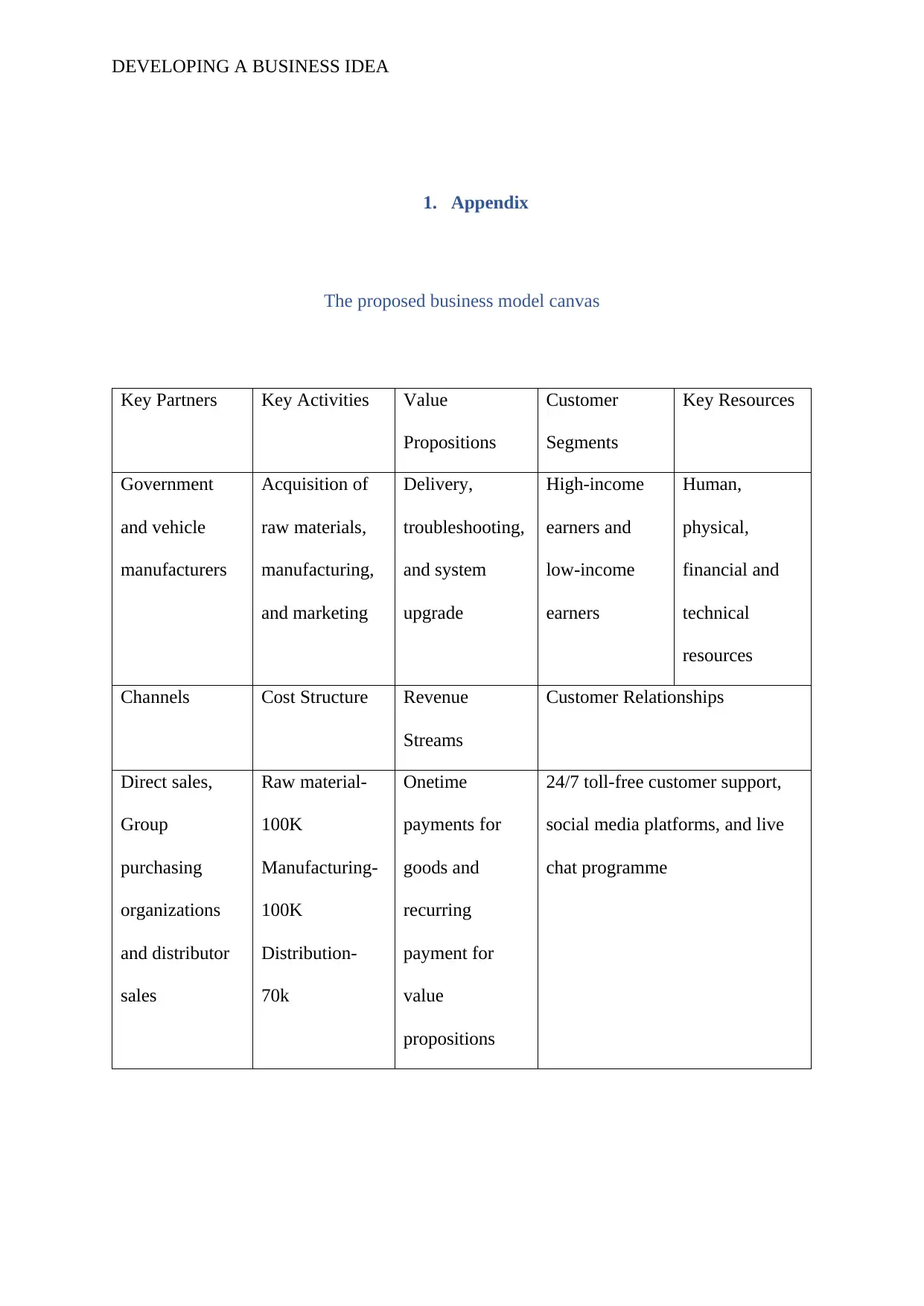
DEVELOPING A BUSINESS IDEA
1. Appendix
The proposed business model canvas
Key Partners Key Activities Value
Propositions
Customer
Segments
Key Resources
Government
and vehicle
manufacturers
Acquisition of
raw materials,
manufacturing,
and marketing
Delivery,
troubleshooting,
and system
upgrade
High-income
earners and
low-income
earners
Human,
physical,
financial and
technical
resources
Channels Cost Structure Revenue
Streams
Customer Relationships
Direct sales,
Group
purchasing
organizations
and distributor
sales
Raw material-
100K
Manufacturing-
100K
Distribution-
70k
Onetime
payments for
goods and
recurring
payment for
value
propositions
24/7 toll-free customer support,
social media platforms, and live
chat programme
1. Appendix
The proposed business model canvas
Key Partners Key Activities Value
Propositions
Customer
Segments
Key Resources
Government
and vehicle
manufacturers
Acquisition of
raw materials,
manufacturing,
and marketing
Delivery,
troubleshooting,
and system
upgrade
High-income
earners and
low-income
earners
Human,
physical,
financial and
technical
resources
Channels Cost Structure Revenue
Streams
Customer Relationships
Direct sales,
Group
purchasing
organizations
and distributor
sales
Raw material-
100K
Manufacturing-
100K
Distribution-
70k
Onetime
payments for
goods and
recurring
payment for
value
propositions
24/7 toll-free customer support,
social media platforms, and live
chat programme
⊘ This is a preview!⊘
Do you want full access?
Subscribe today to unlock all pages.

Trusted by 1+ million students worldwide
1 out of 12
Related Documents
Your All-in-One AI-Powered Toolkit for Academic Success.
+13062052269
info@desklib.com
Available 24*7 on WhatsApp / Email
![[object Object]](/_next/static/media/star-bottom.7253800d.svg)
Unlock your academic potential
Copyright © 2020–2025 A2Z Services. All Rights Reserved. Developed and managed by ZUCOL.





